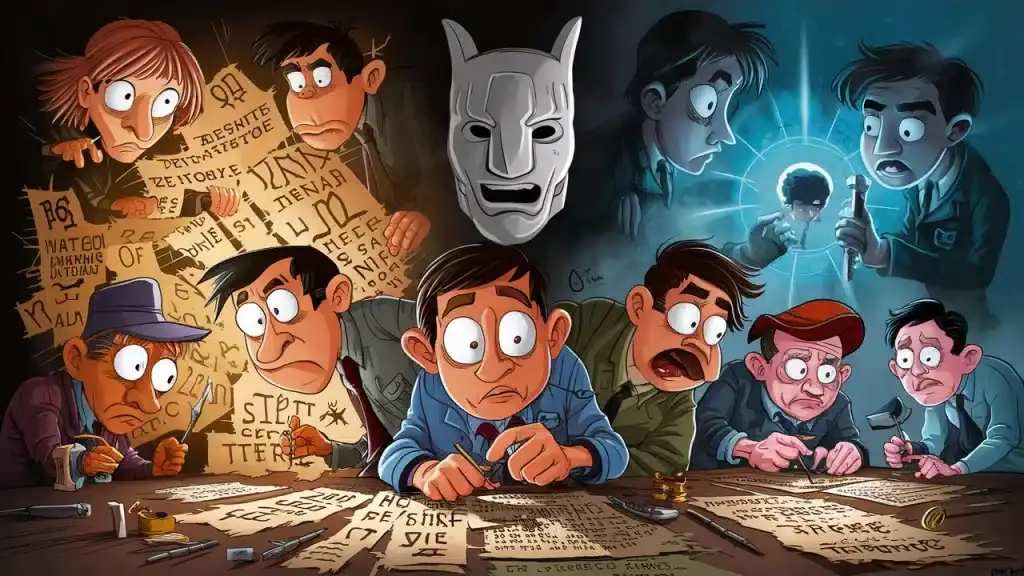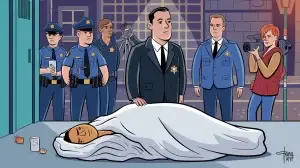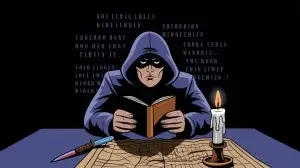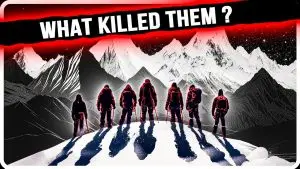The Zodiac Killer is one of America’s most notorious and enigmatic serial killers. Operating in Northern California during the late 1960s, this unidentified murderer claimed at least five lives, taunted police with cryptic messages, and terrified communities with his unpredictable attacks. The real identity of the Zodiac Killer remains unknown to this day, making the case both intriguing and infuriating for investigators and armchair detectives alike.

Many believe the Zodiac Killer’s choice of victims and carefully crafted letters were meant to capture public attention and instill fear.
He targeted young couples and a lone cab driver, leaving a trail of violence that still haunts the Bay Area.
His ciphers, some of which took decades to solve, added a chilling layer to his already menacing reputation.
The Zodiac Killer’s story has inspired numerous movies, books, and documentaries, keeping his legend alive.
Films like the 2007 thriller “Zodiac” and the classic “Dirty Harry” have drawn inspiration from his crimes, ensuring that the mystery remains in popular culture.
Dive into the eerie tale of the Zodiac Killer and uncover the details that have baffled experts for over half a century.
Historical Background
The Zodiac Killer, who operated in Northern California, is known for a series of murders and cryptic messages that baffled both the public and law enforcement.
Timeline of Key Events
In December 1968, the Zodiac Killer’s first confirmed victims were found near Vallejo, in the San Francisco Bay Area.
Over the next year, he claimed more victims, including a young couple in July 1969.
During this period, the killer sent bizarre letters and ciphers to local newspapers.
July 31, 1969: The first letters arrive at the San Francisco Chronicle, the San Francisco Examiner, and Vallejo Times-Herald. Each included one-third of a cipher containing a message supposedly revealing his identity.
October 11, 1969: The Zodiac’s confirmed final victim was a cab driver in San Francisco.
His letters continued into the 1970s, taunting police and claiming up to 37 victims. Despite intense investigation and numerous suspects, the killer’s identity remains unknown (Britannica).
The Bay Area in the 1960s
In the late 1960s, the Bay Area was a hotbed of cultural change and social upheaval.
The counterculture movement was in full swing, centered around San Francisco’s Haight-Ashbury district.
It was a time of peace marches, protest songs, and civil rights battles.
Yet, amidst all this, stark contrasts existed. The Zodiac Killer capitalized on these chaotic times.
Northern California, known for its hills and foggy weather, became a hunting ground.
Despite extensive reporting by local papers like the San Francisco Chronicle, fear and confusion reigned.
These factors created an atmosphere where the Zodiac Killer’s actions stood out sharply. The mix of fear and fascination with the case still haunts the Bay Area today (SF Chronicle).
Notorious Crimes
The Zodiac Killer left a trail of terror in Northern California, claiming the lives of at least five people. His attacks spanned rural roads, remote parks, and even city streets.
Lake Herman Road Attack
On December 20, 1968, high school students Betty Lou Jensen and David Faraday were parked on Lake Herman Road near Vallejo.
Their quiet evening took a deadly turn when the Zodiac Killer approached their car.
The attacker shot David in the head as he got out of the car. Betty Lou tried to run but was shot multiple times as she fled.
Their bodies were found by a passerby later that night.
This double murder marked the start of the Zodiac’s spree. Despite the investigation, no strong leads emerged, making this crime the beginning of a chilling mystery.
Blue Rock Springs Shooting
Just before midnight on July 4, 1969, Darlene Ferrin and Michael Mageau were in a parked car at Blue Rock Springs Park in Vallejo.
The Zodiac arrived and fired into the car, hitting both victims.
Darlene was killed, but Michael survived despite being severely wounded. He later described a man with a flashlight who shot them and then returned to shoot again.
An hour later, the Zodiac called the police to take responsibility for the attack.
He also tied this shooting to the earlier Lake Herman Road murders. Michael’s survival provided some clues, but the killer remained at large.
Lake Berryessa Stabbing
On September 27, 1969, the Zodiac struck again at Lake Berryessa.
College students Bryan Hartnell and Cecelia Shepard were picnicking when a hooded figure with a gun appeared.
The attacker tied them up before brutally stabbing them. Bryan survived but Cecelia died two days later.
The attacker left a message on Bryan’s car door detailing the crime and signed it with a cross-circle symbol.
This attack showed the killer’s willingness to change methods, moving from shooting to stabbing. The chilling calmness of the Zodiac as he committed these acts remains one of the most terrifying aspects of his crimes.
Presidio Heights Murder
The Zodiac’s final confirmed murder occurred on October 11, 1969, when he targeted cab driver Paul Stine in the Presidio Heights area of San Francisco.
After getting into Paul’s taxi, the killer directed him to a quiet intersection.
Without warning, the Zodiac shot Paul in the head and took a piece of his shirt stained with blood.
Police arrived on the scene minutes later, missing the killer by a narrow margin.
The boldness of killing in a busy neighborhood shocked the public. Adding to the chaos, the Zodiac sent a piece of Paul’s shirt to newspapers as proof of his crime, taunting the authorities and the community once again.
Communications with the Media
The Zodiac Killer’s interactions with the media were notorious, featuring both taunting letters and intricate puzzles. These communications aimed to mock authorities and the public.
Letters to Newspapers
The Zodiac Killer sent several letters to newspapers such as the San Francisco Chronicle, often beginning with “This is the Zodiac speaking.”
These letters contained detailed accounts of his crimes and threats of further violence.
They showed a keen awareness of media influence, urging editors to publish his messages to avoid additional killings.
The tone was chilling, yet calm, showcasing the killer’s desire for notoriety.
His letters forced newspapers to grapple with the ethics of publishing his threats, caught between public safety and feeding his ego.
Ciphers and Cryptograms
One of the most baffling aspects of the Zodiac’s communications was his use of ciphers and cryptograms.
He included coded messages in his letters that took decades to crack.
In one famous cipher sent to the San Francisco Chronicle, he claimed it would reveal his identity if solved.
These cryptic puzzles added a layer of intrigue, capturing public and law enforcement attention.
The complexity of these ciphers showcased the Zodiac’s intelligence and desire to control the narrative.
It wasn’t until 51 years later that one of these messages was finally decoded, though it revealed more taunts rather than his true identity.
Efforts to Unmask the Killer
The hunt for the Zodiac Killer has been intense, with both police and public giving it their all. From cracking ciphers to digging into theories, every lead is explored.
Law Enforcement Investigations
The Zodiac Killer terrorized Northern California in the late 1960s and early 1970s.
The police and FBI have been involved deeply in trying to catch him.
The most famous suspects include Arthur Leigh Allen.
Though he seemed a likely killer, evidence was never enough to charge him.
In 2020, an international team of codebreakers cracked the Zodiac’s 340 Cipher, a huge win in the long quest for answers.
Despite these efforts, the killer’s identity remains a gripping mystery.
Public Speculation and Theories
The Zodiac Killer’s identity sparked much public interest, leading to numerous theories.
Some investigators claim the FBI secretly listed a suspect since 2016.
Armchair detectives have also tried cracking the killer’s cryptic messages for decades.
The intense media coverage and public fascination keep old and new theories alive.
The Zodiac’s cryptic letters and ciphers have inspired countless amateur sleuths to dive into the mystery, hoping to crack the case wide open.
Social media and online forums continue to buzz with fresh ideas and leads.
Cultural Impact

The Zodiac Killer left a lasting mark on both media and culture. His mysterious and unsolved crimes have inspired numerous films, books, and maintained a strong grip on the public imagination even decades later.
Inspiration for Films and Books
From the moment the Zodiac Killer’s crimes hit the news, he became a figure of dark fascination.
The 1971 movie Dirty Harry drew inspiration directly from the Zodiac case, with Clint Eastwood playing a cop hunting a serial killer in San Francisco. This film helped cement the killer’s image in pop culture.
Robert Graysmith’s books on the Zodiac case, including Zodiac and Zodiac Unmasked, investigated the crimes and the potential identity of the killer.
These works provided a foundation for the 2007 film Zodiac, directed by David Fincher, which explored the case in depth.
The killer’s encrypted messages and unique modus operandi continue to inspire creative works and keep the story alive.
Enduring Public Fascination
People remain intrigued by the mystery surrounding the Zodiac Killer.
The case has a haunting, almost mythic quality thanks to the killer’s unresolved identity and cryptic communications.
This mystery captivates new generations, as seen through numerous documentaries, TV specials, and podcasts that explore the Zodiac’s crimes and possible suspects.
Even decades later, the Zodiac Killer remains a topic of discussion and speculation.
The public’s yearning for closure keeps the case in the spotlight, and each potential breakthrough rekindles interest.
The combination of horror, intrigue, and the unknown keeps the Zodiac Killer a permanent fixture in true crime lore.
Scientific Breakthroughs

Some key scientific breakthroughs have shed new light on the Zodiac Killer case. These include significant progress in code-breaking technologies and advancements in DNA analysis techniques.
Code-Breaking Developments
For years, both amateur and professional code-breakers were stumped by the Zodiac Killer’s cryptic messages. A major milestone was reached when a team decoded the infamous 340-Character Cipher. This complex code had baffled experts for over 51 years.
Using modern computational power and new algorithms, code-breakers were able to reveal the hidden message. The message didn’t provide the killer’s identity but offered insight into his twisted mind. The breakthrough was confirmed by the FBI, shedding light on the enigmatic letters sent by the criminal.
DNA Analysis
In addition to cracking ciphers, advances in DNA analysis have played a crucial role. DNA evidence has transformed criminal investigations, offering new hope for unmasking elusive criminals. Researchers are using genetic genealogy to trace the Zodiac Killer’s origins.
Previously, the case lacked sufficient DNA material, but improved techniques have allowed forensic experts to extract valuable genetic fingerprints. This approach has led to identifying distant relatives and building a possible family tree for the killer. Although the Zodiac’s identity remains unconfirmed, these DNA advances provide valuable insights that bring investigators closer to solving the long-standing mystery.
Unsolved Mysteries
The Zodiac Killer remains one of the most infamous cold cases. Despite decades of investigation, the identity of this serial killer is still unknown.
Between 1968 and 1969, the Zodiac Killer is known to have murdered five people in Northern California, specifically the San Francisco Bay Area. He targeted young couples, as well as a lone male cab driver.
Why is it still an unsolved mystery?
- Lack of Identifiable Evidence: The Zodiac’s cryptic letters and ciphers left police and cryptologists guessing. Even with advances in forensic science, they haven’t cracked the code to his true identity.
- Multiple Suspects: Over the years, many suspects have been proposed, including a man whose own son suspects him of being the Zodiac. Yet, no solid evidence links any suspect definitively to the crimes.
- Elusive Nature: The Zodiac carefully avoided leaving behind traceable evidence. This unknown serial killer’s ability to remain a step ahead has baffled experts and armchair detectives alike.
- Ongoing Theories: Theories range from plausible to wildly conspiratorial. Each new lead sparks renewed public interest but often leads to dead ends, leaving his identity shrouded in mystery.
Reflections on Justice

The Zodiac Killer’s reign of terror left lasting scars on victims’ families and taught law enforcement crucial lessons. The quest for justice has been ongoing, touching many lives and shaping investigative practices.
Impact on Victims’ Families
The families of the Zodiac Killer’s victims have endured immense pain and loss. Each murder shattered their lives, creating ripples of sorrow and unanswered questions. The constant media attention often reopened wounds, making healing a daunting task.
While some families sought closure through public memorials and advocacy, others chose privacy to cope with their grief. The lack of definitive justice and the unsolved status of the cases kept many in a heartbreaking limbo. The Zodiac’s taunting letters only added to their torment, serving as cruel reminders of their loved ones’ tragic ends.
Families also faced frustration with the slow pace of investigations. They yearned for a resolution, a name, and a face to hold accountable. This longing for justice became a lifelong journey, marked by intermittent hope and despair.
Law Enforcement Learnings
Investigating the Zodiac Killer case pushed law enforcement to its limits. The complex ciphers and cryptic messages demanded innovative thinking and collaboration across agencies.
The case underscored the urgent need for better communication and resource-sharing between departments.
One significant lesson was the importance of involving the public. Crowdsourcing efforts to decode messages led to breakthroughs that might have otherwise been missed.
The Zodiac’s case highlighted gaps in forensic technology of the time, driving advancements that benefit today’s investigations.
Another takeaway was the role of media in shaping public perception and aiding investigations. Law enforcement learned to balance transparency with strategic information release.
The Zodiac Killer’s case remains a poignant reminder of the perpetual struggle between criminal minds and justice-seeking authorities.
Steve is the creative force behind Unique Tales, a blog dedicated to sharing captivating stories that explore the human experience in all its complexity. With a passion for writing and a talent for crafting engaging narratives, Steve's blog is a treasure trove of imaginative tales that transport readers to other worlds and challenge them to see things from new perspectives. From epic adventures to intimate character studies, Steve's stories are always thought-provoking and emotionally resonant. With a growing following of readers who appreciate his unique voice and creative vision, Steve is quickly becoming a rising star in the world of online storytelling.






